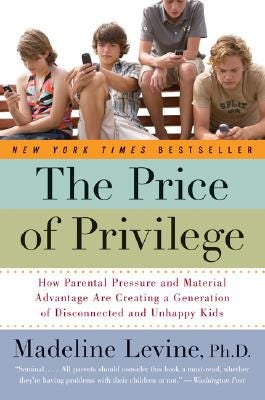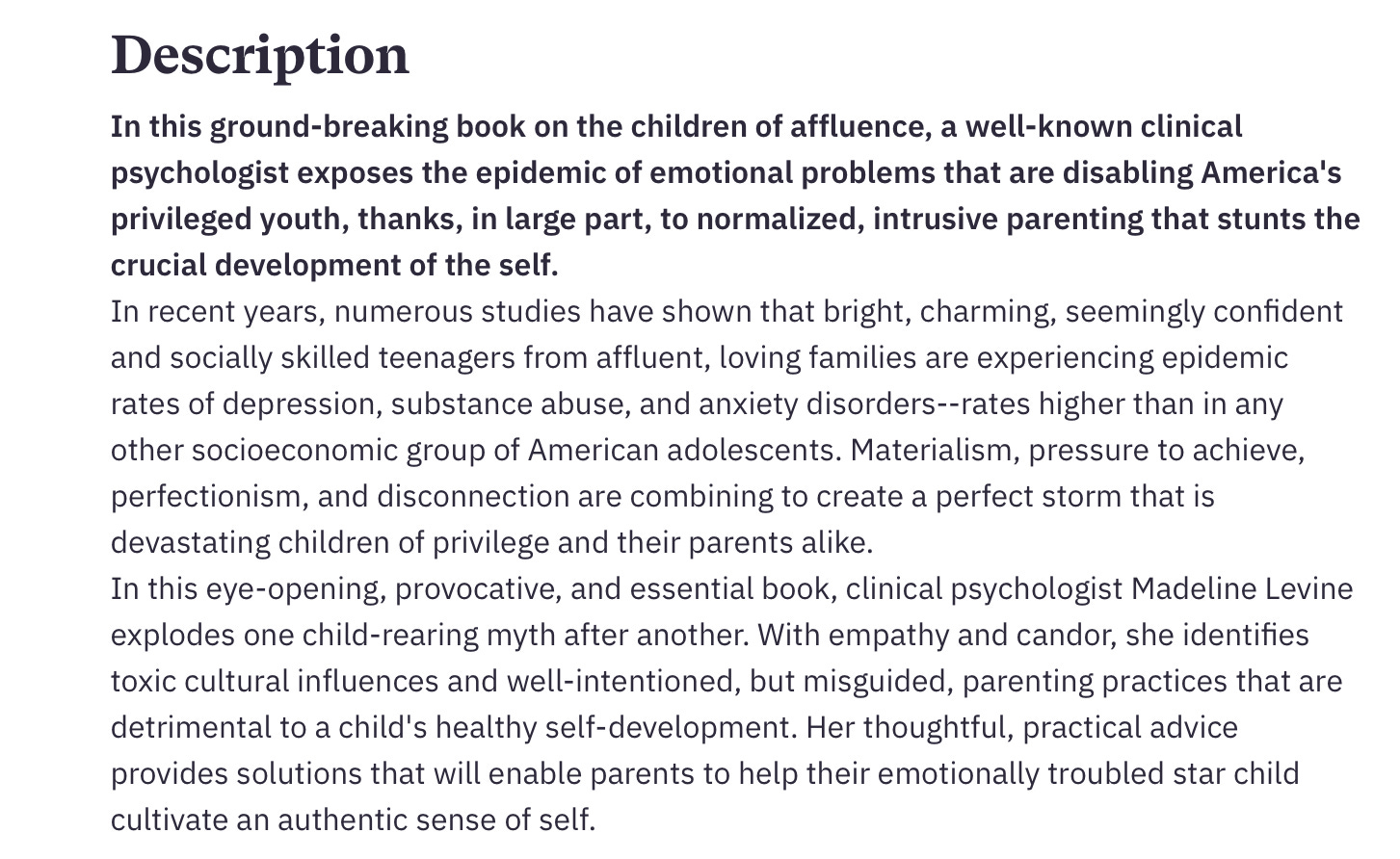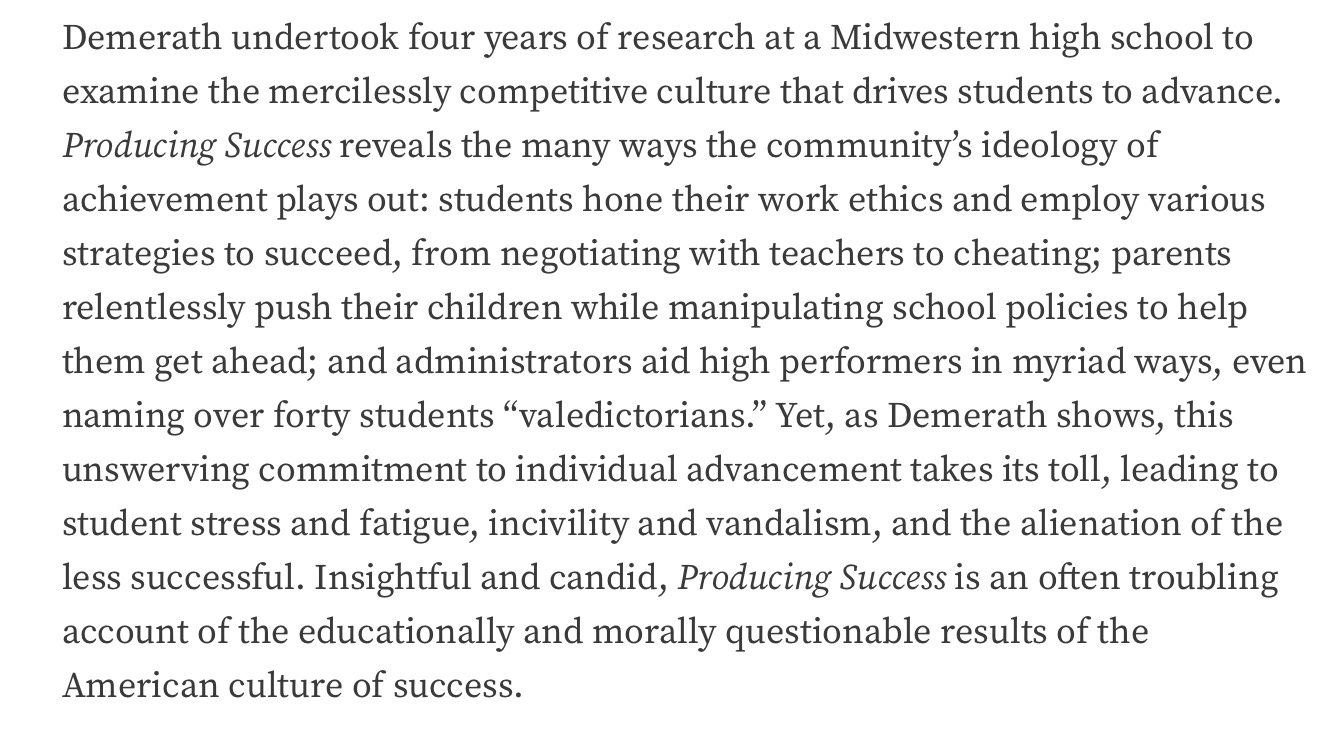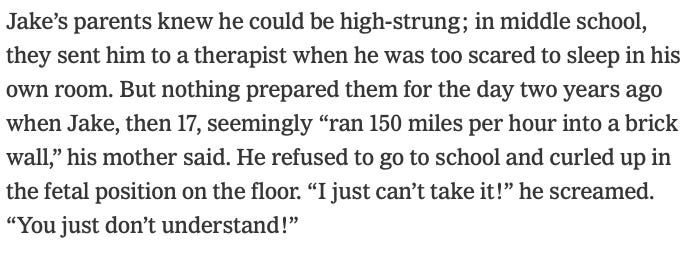Teen Mental Health Distress Didn't Start with the Phones
On this claim, Jonathan Haidt is demonstrably wrong.
This past week, Jonathan Haidt, New York University professor of psychology and co-author (with Greg Lukianoff) of The Coddling the American Mind: How Good Intentions are Setting Up a Generation for Failure (2018), tweeted this out as a tease to a post at his Substack newsletter:
There is a lot to say about the full scope of Haidt’s theory, and I started to say all that stuff in a post that started to get far too long and involved, but that I will return to in a future installment (or two or three) because I think these issues are very important.
But today, I want to focus on one point. When Haidt says there was “no sign of a teen mental illness epidemic until around 2012,” he is wrong.
Saying there was no sign of a teen mental health epidemic until around 2012 is the equivalent of looking back to February 2020 when the Diamond Princess cruise ship saw a massive outbreak of coronavirus, ultimately killing more than a dozen people, and declaring there was no sign of an impending viral pandemic.
Haidt has constructed a timeline convenient to his narrative that smart phones/social media are the cause of mental distress among teenagers, but the distress was present long before the ubiquity of social media use.
Madeline Levine is a clinical psychologist who spent her career working as a therapist with the children of affluent families in California. The Price of Privilege: How Parental Pressure and Material Advantage are Creating a Generation of Disconnected and Unhappy Kids was published in 2006, and based in work Levine had been doing with young people years before that, an era well in advance of Haidt’s 2012 inception point.
This is the book’s description:
“A well-known clinical psychologist exposes the epidemic of emotional problems.”
Seems like there was an epidemic before Haidt’s epidemic.
Producing Success: The Culture of Advancement in an American High School by Peter Demerath was published by the University of Chicago Press in 2009, and reflected Demerath’s research conducted over a period of four years, taking it back to the early 2000s.
The book is described this way:
“…this unswerving commitment to individual advancement takes its toll, leading to student stress and fatigue, incivility, and vandalism, and the alienation of the less successful.”
One of Haidt’s chief indicators of the psychological pathology he calls “safetyism” in Coddling is incivility.
A 2015 article from the New York Times, “Suicide on Campus and the Pressure of Perfection” focuses on 20-year-old Kathryn DeWitt, a student at the University of Pennsylvania who reacted to the January 2014 suicide death of her classmate Madison Holleran by exclaiming, in her blog, “What the hell, girl?! I was supposed to be the one who went first! You had so much to live for!”
At the time of Holleran’s death, DeWitt had made a suicide plan, buying razor blades and writing notes to her loved ones. DeWitt fortunately got the help she needed, but U. Penn saw six suicides over a 13 month period.
Having been driven by a culture to find self-worth in her achievements, DeWitt was crushed by a poor grade on a calculus exam. She told the article’s author, Julie Scelfo:
Scelfo’s article cites numerous studies and indicators of student mental health problems prior to 2012, including a 2003 study at Duke University which described, “how its female students felt pressure to be “effortlessly perfect”: smart, accomplished, fit, beautiful and popular, all without visible effort.”
DeWitt talks about the pressures of a life of trying to live up to societal and cultural expectations and gradually being worn down in the process until she came perilously close to taking her own life.
The article also quotes Julie Lythcott-Haims, a former dean at Stanford who immediately became concerned about student attitudes towards achievement upon taking the job in 2002. Lythcott-Haims’ experiences resulted in the publication of her 2012 book, How to Raise an Adult: Break Free of the Overparenting Trap and Prepare Your Kid for Success.
In the book, Lythcott-Haims discusses the need for students to develop their own sense of self and to be able to learn from failure without parents swooping in to save them.
To some degree, this dovetails with Haidt and Lukianoff’s theory of “safetyism,” but their emphasis is on what they see as overprotection of students’ “emotional” safety. Lythcott-Haims is taking aim at parents who are trying to protect their child’s socioeconomic status and material advantages through overparenting.
These are important distinctions.
Another 2015 article from the Times asks, “Why Are More Teenage Americans Suffering from Anxiety?”
This story focuses on Jake, who two years earlier, had a breakdown over the stress of his life:
Jake was sent to a residential treatment facility for help alongside other young people experiencing similar struggles. The commonly shared issue, according to the therapists at the facility:
The children that Levine counsels describe themselves as “empty.” In her follow-up book, 2012’s Teach Your Children Well: Why Values and Coping Skills Matter More than Grades, Trophies, or Fat Envelopes, Levine describes a young woman who has been so emotionally devastated by not getting into her first choice college, she cannot get out of bed telling Levine, “It was all for nothing. I’m a complete failure.”
Levine writes, “The cost of this relentless drive to perform at unrealistically high levels is a generation of kids who resemble nothing so much as trauma victims.”
All of this happened prior to 2012.
What we’re looking at, I believe, is the phenomenon of “toxic meritocracy,” a term I picked up from Aaron Rabinowitz, a lecturer of philosophy at Rutgers and host of the Embrace the Void Podcast, and which also may be redundant because really, we’re just talking about the meritocracy, a term coined as a satirical name for attitudes among the elite that came to embraced by the elite in order to justify their control over the status quo.
Over time, a culture shaped by meritocratic ideals around achievement, particularly in school as a route to a good life, has turned schools from places of potential solace and personal development into gauntlets that wear young people down down bit by bit until they break.
(If you want to know what toxic meritocracy looks like all grown up, check out my previous post exploring “the Fleishman Effect.”):
While it may have started in the kind of community in which Levine practices, or elite schools like Stanford, Duke, and U. Penn, over time it has become pervasive
Like Levine, and Demerath, and Lythcott-Haims, I also saw significant evidence of student mental health distress that is rooted in years earlier than 2012. After years of seeing this with my own eyes, in 2012, during my earliest days of blogging for Inside Higher Ed, I wrote about the high incidence of students crying in my office, often in response to what I thought was an innocuous or even salutary comment like “only two weeks left in the semester!” I thought we were about to celebrate the chance to revel in our successful completion of another semester of work.
Students were panicked about how they were going to complete everything they needed to do in two week’s time. First-year students reported having had their first school-related anxiety attack as early as fifth grade.
Over time, I came to believe that students were often understandably crumbling in the face of a system that denied them the chance to form stable self-concepts and self-images because they were too busy achieving.
They had not been coddled, they’d been defeated.
I am not alone. Writing in 2015 (and recently republished at his new newsletter), Peter Greene, a teacher with over thirty years experience, wrote about seeing the same phenomenon in his students several years earlier when his best students were afraid of making, “one wrong move” lest they be punished by an unforgiving system.
These students were not experiencing distress because a switch had been thrown on social media in 2012 as Haidt contends. They were operating under years of stress and had reached a breaking point.
Greene describes how, acting atypically, he got emotional, and felt compelled to try to reassure these students that they would survive this world that seemed so hostile to them.
In hearing his message about his students Greene reports, “Some bowed their heads. Some just sat. And some wept.”
I recognize that I have more work to do to engage with Jonathan Haidt’s full theory of the case when it comes to the mental health of young people, and in the end, I think we will find significant agreement in terms of the necessary remedies to help those young people thrive in today’s world.
I am also more than open to the idea that social media has intensified and accelerated the potential for teens to experience “negative social comparison,” a source of depression and anxiety.
But as to Haidt’s claim that there were no signs of an epidemic prior to 2012 - a date which allows him to claim smart phones are a direct cause of the distress, as opposed to a vector through which an existing virus spread - he is simply wrong.
If it is the phones, they opened the gates on a well-documented, pre-existing phenomenon.
That’s important.
Because if we’re going to collaborate on things that will help relieve the stress of young people in America, it will require us to get to the roots of the problem.
Links
While everyone else seems to want to lament the decline of the humanities, I’m over here shouting “English majors can do stuff” at the Chicago Tribune
The 2023 Tournament of Books is officially underway, with three matches in the books and more running through the month of March. Winners include My Volcano by John Elizabeth Stintzi in the play-in round, and Mouth to Mouth by Antoine Wilson and The Book of Goose by Yiyun Li in the main draw.
At The New Yorker, Katy Waldman takes a closer look at some of the books that the Florida book banners are trying to ban. In other news, one of the targets in Florida is Jodi Picoult, who is fighting back.
At the New York Times, Sarah Weinman looks at all things Patricia Highsmith, one of my all-time favorite writers.
Apparently there’s now a musical based on S.E. Hinton’s classic The Outsiders playing in Los Angeles. You gotta figure the show-stopping 11 o’clock number is titled, “Stay Gold Ponyboy! Stay Gold!”
Recommendations
All links to books from this site go to Bookshop.org, and affiliate income will be donated to Open Books of Chicago, and another book or reading-related charity to be named later. (Make a recommendation in the comments!)
1. “Daisy Jones and the Six” by Taylor Jenkins Reid
2. “The Paris Apartment” by Lucy Foley
3. “The Maidens” by Alex Michaelides
4. “The Silent Patient” by Alex Michaelides
5. “The Southern Book Club’s Guide to Slaying Vampires” by Grady Hendrix
Jean S. - Elgin, IL
Laura Lippman’s Dream Girl should provide the tension and intrigue that seems to be part of her desired reading experience.
That’s all for this week folks. Once again, be sure to check out this year’s Tournament of Books!














When Haidt wrote "there is no sign of teen mental health epidemic before 2012", he was literally talking about the "Monitoring the Future" dataset (the graphic at the top of this piece), which indeed shows 35 years of flat results and then begins to spike for liberal girls in 2012 and then for everyone else shortly after.
He certainly wasn't saying that there were no issues at all with youth prior to 2012. In fact, in the very essay you're talking about, Haidt specifically talk about the how the movement toward more kids having an external "locus of control" began in the 1990s when parents stopped letting kids play on their own outside.
But he clearly does think that something important changed around 2012; he is basing that conclusion on real research data; and he makes a pretty compelling case for why we should be looking at phones and social media.
Now if you disagree with his conclusions, I'd be interested in hearing why, so I'm looking forward to your subsequent essays. But simply finding examples of people writing complaints about the youth today from before 2012 won't do the trick. Without doing any research, I'll guarantee that you can find examples of that phenomenon from every year since we've had newspapers.
If you're going to make a serious argument that Haidt is wrong, you either need to find holes in the data he's looking at that show a spike in 2012 or explain why that data isn't important and what data we should be looking at instead. Looking forward to seeing your argument.
I’ve been so frustrated with the narrative around the latest teen mental health study results, so I truly appreciate your thoughts and the resources you provide. I was part of a 10-year strategic planning committee with my local school district in 2019-20. The first meeting focused on a student panel. Every single one of them told us they were tired of only being a number (GPA). They said a version of this in answer to virtually every question posed. The committee had some limited discussion about eliminating class ranking, with the majority of parents being highly opposed. In the end, the district opted to continue as is. All of this made me think back to my high school years (I graduated in 1985). I honestly do not remember there ever being talk about GPA or class rank beyond who the valedictorian might be (which we only thought about in the week or two before graduation). My daughter graduated in 2020 and class rank in her peer group (all top 10% students) was a daily conversation starting in sophomore year. Our high school is so large (her class graduated 1,742 students), GPA’s are figured to five decimals, so they would freak out over a 99 vs. a 100. The pressure was intense! Referring back to my experience with the student panel and the district’s decision to maintain the status quo; adding to the intense pressure was the knowledge that they had ZERO power to change anything and that the panel had been nothing more than a performative exercise—tell us what you think, but we don’t intend to listen. I feel strongly that Mr. Greene was on to something in 2015, something that has only intensified in the years since, and that is this narrative, particularly among the upper and upper middle class, that failure simply isn’t an option. That to fail in 5th or 6th grade is to fail for the rest of your life. And, to be clear, failure here isn’t real failure. For this cohort and their parents failure is defined as ANYTHING less than perfect. Phones are not what’s wrong with kids. We parents are what’s wrong with kids!